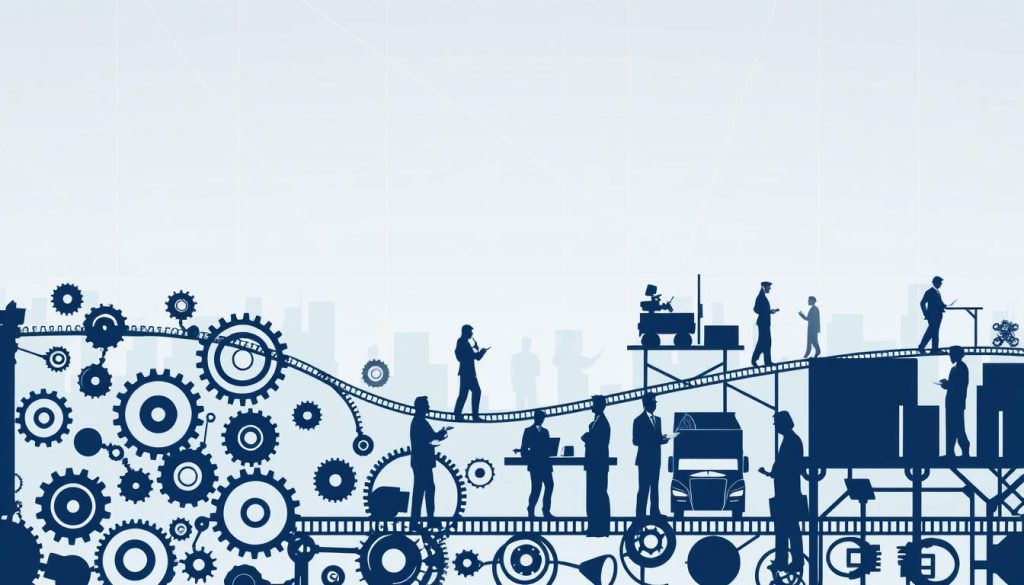What is a Supply Chain?
A supply chain is the complete system that brings a product or service from its initial stages to the final delivery. It involves coordinating various organizations, individuals, activities, information, and resources.
These elements transform raw materials into finished goods. Key U.S. references, such as NIST SP 800-37 Rev. 2 and NIST SP 800-53 Rev. 5, outline this complex network. They highlight its role in planning, control, and managing risks.
The modern supply chain is a dynamic network, not a straightforward line. It involves at least three entities: upstream suppliers, a central firm, and downstream customers. The process includes design, development, manufacturing, and delivery. Information and finance flow alongside goods. Used products can also be recycled, promoting circular flows and better asset recovery.
Suppliers are categorized into tiers. First-tier suppliers directly sell to the central enterprise, while second-tier suppliers serve the first tier. Production stages involve component manufacturing and assembly.
Distribution stages ensure goods reach customers efficiently and at controlled costs. These aspects underscore the critical role of supply chain performance in achieving high service levels, resilience, and growth.
In U.S. commerce, companies compete as networks. A clear supply chain definition, combined with disciplined process execution, translates strategy into tangible outcomes. Recognizing the significance of supply chain design and governance enables leaders to enhance cost, quality, and lead time. It also ensures compliance and continuity.
Supply Chain Definition and Core Concepts for U.S. Businesses
U.S. executives must grasp the supply chain definition to establish policies, assess risks, and direct investments. Supply chain management encompasses planning, sourcing, production, delivery, and support of products and services. It guides logistics and supply chain decisions, aligning with the company’s overall strategy.
Standard definitions from industry and government (NIST, CNSSI)
The National Institute of Standards and Technology defines a supply chain as a network of resources and processes across various tiers. It includes design, development, manufacturing, handling, and delivery to the end user.
Committee on National Security Systems Instruction 4009 views it as a global system of organizations, people, activities, information, and resources supplying products or services to consumers.
These definitions extend beyond mere transportation. They emphasize the importance of supply chain management in upstream procurement and production, as well as downstream distribution and service. This perspective goes beyond logistics and supply chain operations.
From raw materials to end customers: a network, not a linear chain
Today’s systems operate as demand-driven networks. Orders prompt coordinated plans across suppliers, plants, and distribution centers to align with end-customer demand. Components and assemblies move forward, while information and cash flow in both directions.
This network approach aids in making practical decisions on capacity, inventory placement, and service levels. It links supply chain strategy to market positioning, balancing speed, cost, and risk.
Tiers of suppliers and the role of extended enterprises
Suppliers are categorized by tier. First-tier firms directly interact with the buyer. Second- and third-tier providers supply inputs upstream, such as raw materials, subassemblies, or specialized services. Enhanced visibility across tiers reduces disruption exposure and improves quality assurance.
The extended enterprise functions as a loosely coupled, multi-firm system. Companies coordinate schedules, data, and standards to reduce waste and maintain flexibility.
This model supports selective tight coupling, like vendor-managed inventory, to cut lead times. It also allows for looser links where product variety or innovation demands agility within logistics and supply chain networks.
For U.S. businesses, these principles integrate governance, analytics, and technology. A clear supply chain definition, disciplined management, and a coherent strategy lead to measurable performance in cost, service, and resilience.
What is a Supply Chain?
A supply chain encompasses the entire process of producing and delivering goods and services. It includes raw material extraction, processing, manufacturing, distribution, and retail. It also involves tracking information and cash flows that connect these stages, influencing planning, sourcing, and delivery.
The supply chain process begins with materials sourced by rail, truck, air, or ocean carriers to suppliers and wholesalers. Manufacturers then transform these inputs into finished products.
Distributors sell to retailers, who in turn serve end consumers. Demand data flows back through point-of-sale systems and ERP platforms to align production with actual orders.
E-commerce introduces additional service layers. Orders are captured on platforms like Shopify. Payments are processed through PayPal, Stripe, or banks. Warehouses, either in-house or through 3PLs like DHL Supply Chain and GXO, manage inventory.
Carriers such as UPS, FedEx, and USPS handle the final delivery. Returns and recycling can recycle parts and materials back into production, utilizing residual value.
Executives use mapping to assess market position and options across various business lines. Clear maps reveal cost drivers, lead-time risks, and opportunities for optimization. They highlight areas for improving efficiency, including network design, inventory placement, and data visibility.
The goal is to ensure a seamless flow from source to customer, with performance measured at each stage. Focusing on the supply chain process clarifies which partners add value, how signals translate into plans, and where continuous improvement can enhance efficiency without compromising service levels.
| Stage | Primary Actors | Key Flows | Performance Focus | Typical Metrics |
|---|---|---|---|---|
| Extraction & Processing | Miners, refiners, chemical processors | Raw materials, quality data, contracts | Supply stability, specification compliance | Yield rate, supplier lead time, cost per ton |
| Manufacturing & Assembly | OEMs, contract manufacturers | Components, production schedules, work orders | Throughput, changeover agility | OEE, first-pass yield, cycle time |
| Distribution | 3PLs, wholesalers, DCs | Pallets, cartons, ASN data | Network cost, service levels | Fill rate, on-time in-full, cost per order |
| Retail & E‑Commerce | Retailers, Shopify stores, marketplaces | Orders, demand signals, payments | Availability, conversion | Stockout rate, order cycle time, AOV |
| Reverse & Circular | Service centers, recyclers | Returns, refurb parts, materials | Recovery value, waste reduction | Return rate, recovery yield, disposal cost |
| Optimization Layer | Planners, analysts, technology providers | Forecasts, inventory policies, network models | Supply chain optimization and resilience | Forecast accuracy, total landed cost, asset turns |
These stages and flows offer a practical view of what constitutes a supply chain. They support decisions on design, sourcing, and service. Consistent metrics and disciplined reviews promote optimization while maintaining efficiency at scale.
How Supply Chains Work: From Production to Distribution
In the U.S., firms operate a networked system that connects plants, warehouses, and carriers through data and financial flows.
This system coordinates production, movement, and returns to enhance supply chain efficiency while managing risk and cost. Effective supply chain management ensures operations align with demand signals and service goals across various industries.
Production Stage: Sourcing, Manufacturing, and Assembly
The production phase begins with sourcing. Raw materials from miners, growers, and chemical producers are used in component lines. Contract manufacturers like Foxconn and Jabil then assemble these components into finished goods.
Break-even analysis varies by tier. Upstream sites compare production costs with market prices. Downstream plants evaluate changeovers, labor, and transaction costs against selling prices and service goals. Lean cells, statistical process control, and quality gates support efficiency from start to finish.
Distribution Stage: Regional and Central Distribution Centers
After production, inventory moves to central distribution centers for national pooling and to regional centers for local demand. Cross-docking shifts goods from inbound to outbound lanes, speeding up delivery and reducing costs. Carriers use road transport for flexibility, maritime for scale, and commercial aviation for urgent needs.
Warehouse management systems and distribution resource planning optimize slotting, reorder points, and lane capacity. These tools, integrated with logistics partners, improve fill rates and reduce dwell times, supporting multi-node replenishment.
Information and Finance Flows Alongside Products
Data and financial transactions accompany goods. Point-of-sale demand, EDI orders, and ASN updates connect various stakeholders. Payment terms, chargebacks, and rebates synchronize cash cycles with material flow, a core supply chain management premise.
Research indicates that accurate information exchange reduces bullwhip effects. Clean master data and shared forecasts stabilize production plans, enhance route planning, and protect margins.
Returns, Recycling, and Circular Flows of Residual Value
Returns and reverse logistics recover value through repair, refurbishment, or certified recycling. Parts with residual value reenter the supply chain, reducing waste and material costs. Packaging is consolidated, and components are harvested under documented quality standards.
Closed-loop practices link forward and reverse networks with clear triage rules. This integrated approach aligns logistics and supply chain operations with environmental goals and financial controls, boosting efficiency without compromising service.
| Flow | Main Activities | Primary Systems | Economic Focus | Modal Options |
|---|---|---|---|---|
| Production | Sourcing raw inputs, fabrication, assembly, testing | MES, quality management, capacity planning | Unit cost, yield, takt time, break-even by tier | Inbound road and maritime for bulk supply |
| Distribution | Pooling in CDCs, RDC replenishment, cross-docking | WMS, DRP, transportation planning | Fill rate, order cycle time, handling cost | Road, maritime, commercial aviation |
| Information | Forecasts, orders, ASNs, performance reporting | ERP, EDI, control towers, inventory visibility | Forecast accuracy, bullwhip reduction | Digital networks across all nodes |
| Finance | Invoicing, payment, rebates, working capital control | AR/AP, treasury, trade finance platforms | Cash-to-cash cycle, cost of capital | Banking rails and settlement networks |
| Reverse | Returns triage, refurbishment, recycling, disposal | RMA systems, quality tracking, compliance | Residual value recovery, waste reduction | Road networks for consolidated backhauls |
Logistics and Supply Chain: What’s the Difference?
Logistics and supply chain operate at different scales. Logistics deals with the internal aspects of an enterprise, such as transportation, warehousing, and inventory management. It focuses on service quality, timely delivery, and cost efficiency. On the other hand, the supply chain encompasses a broader network, including procurement, manufacturing, and distribution across multiple companies.
A supply chain definition clearly places logistics within a larger framework. Supply chain management oversees the overall strategy, including sourcing, production planning, and network design. Logistics, then, is responsible for the physical movement of goods. This distinction is critical for resource allocation, risk management, and performance evaluation. Leaders ensure that logistics metrics align with the supply chain strategy.
Historically, studies focused on internal processes. Today, the emphasis is on inter-organizational coordination among brands like Apple and Walmart. Contract manufacturing and drop-shipping are common practices. Third-party logistics providers, such as UPS and DHL, offer dedicated services, allowing for flexible costs and rapid scaling.
Cloud-based platforms enhance visibility from purchase order to delivery. They enable planners to track inventory and production in real-time. Offline mobile apps support field inventory management, improving inventory accuracy and delivery confirmation. These tools ensure that logistics and supply chain decisions are synchronized.
Decision rights define who sets policies and who executes them. Supply chain management determines network structure, supplier selection, and inventory levels. Logistics, on the other hand, handles carrier selection, load planning, and warehouse operations to fulfill service commitments. When the supply chain strategy evolves, logistics adjusts its operations to meet the new objectives.
This coordination ensures a harmonized system. Strategy is set at the enterprise level, while operations are managed at the site and lane levels. With a clear understanding of the supply chain, companies can optimize resource allocation. Logistics, in turn, ensures the efficient movement of goods.
Supply Chain Process Mapping and Strategy Alignment
Process maps simplify complex supply chains, showing who’s involved, what moves, and where risks lie. They connect daily operations to a unified supply chain strategy. Teams use them to pinpoint where to focus on optimization for the greatest returns.
Why mapping matters for strategic planning and market positioning
Mapping aids in understanding market boundaries and profit areas. It reveals where the company competes, who holds power, and which points control lead times. This information guides decisions on integration, make-or-buy, and network design, ensuring strategy alignment.
Executives can test scenarios before investing. By analyzing cycle time, landed cost, and variability, they evaluate the impact of supply chain factors on pricing and service. This leads to focused optimization efforts, not broad, aimless initiatives.
Identifying industries at each stage (extraction, manufacturing, retail)
Effective maps label industries at each stage: mining and agriculture for extraction, chemicals and metals for processing, electronics and automotive for component manufacturing, and grocery, pharmacy, and e-commerce for retail. Distribution and parcel carriers link these tiers.
Highlighting throughput, defect rates, and cash-to-cash cycle time at each stage shows where small improvements can lead to significant gains. This aligns the supply chain with product design, inventory policy, and channel strategy.
Direct, extended, and ultimate supply chains
A direct chain includes the company, its immediate supplier, and its immediate customer. The extended chain adds the supplier’s suppliers and the customer’s customers. The ultimate chain includes all organizations upstream and downstream that affect flow.
Firms often manage different levels simultaneously. A brand may work closely with a tier-1 contract manufacturer while monitoring tier-2 semiconductor capacity through industry data. Each level informs optimization choices and risk management.
Buyer–seller relations and collaboration models
Buyer–seller relations define how information, capital, and material move. Tightly coupled models, such as vendor-managed inventory with Walmart or just-in-sequence delivery in automotive, reduce buffers and lower stock-out risk. They require shared forecasts and service-level accountability.
Loosely coupled models favor flexibility, common in fashion and seasonal goods. Brands mix contract terms, dual sourcing, and 3PL use with UPS, FedEx, or DHL to keep options open. Mapping clarifies where to integrate, where to outsource, and how to pace investment to match market volatility and supply chain performance importance.
- Integration targets: nodes with high variability or high margin impact.
- Outsourcing levers: transportation, fulfillment, and reverse logistics.
- Governance rules: service levels, pricing mechanisms, and data cadence.
Across these choices, the supply chain process map acts as the operating blueprint. It keeps teams aligned on priorities and supports continuous supply chain optimization as demand, capacity, and technology shift.
Reference Models and Management Systems That Improve Performance
Enterprises align their supply chain management with measurable outcomes using established reference models. These frameworks guide optimization, enhance efficiency, and link strategy to daily operations. They cover logistics and supply chain operations.
SCOR model scope and key performance dimensions
The SCOR model, developed by the Supply Chain Council and advanced by APICS, spans from the supplier’s supplier to the customer’s customer. It structures plan, source, make, deliver, return, and enable. This standardizes analysis and drives optimization.
Organizations track over 150 metrics, including on-time delivery and production flexibility. These measures connect supply chain management with finance, risk, and service goals.
Global Supply Chain Forum process framework
The Global Supply Chain Forum outlines eight cross-functional processes that operate across firms. Customer and supplier relationship management form the core linkages. They coordinate demand, capacity, and quality across logistics and supply chain networks.
This framework supports segmentation, collaborative planning, and synchronized performance targets. It enables consistent policies for service levels and product flow.
APQC Process Classification Framework
APQC’s Process Classification Framework provides an open, industry-neutral taxonomy. It covers 12 enterprise categories and over 1,000 processes and activities. It enables benchmarking and process ownership aligned to supply chain management goals.
Firms use the taxonomy to map end-to-end workflows and assign accountability. It clarifies improvement priorities and supports data governance.
Tools: WMS, TMS, DRP, fleet and inventory management
Operational systems translate frameworks into execution. Warehouse management systems control inventory, picking, and fulfillment. Transportation management systems handle routing and carrier procurement.
Distribution resource planning sets network replenishment across nodes. Fleet management improves utilization and compliance for commercial vehicles. Field inventory management tracks dispersed parts and tools. Together, these tools enhance supply chain optimization through visibility and accuracy.
Importance of Supply Chain for Customer Responsiveness and Growth
Customer responsiveness hinges on the efficiency of converting demand into available products. Executives prioritize cost, lead time, and quality, highlighting the critical role of supply chain design. Understanding what a supply chain is and implementing a strategic approach helps teams align with actual customer behavior. This enhances overall supply chain performance.
Linking supply chain processes to end-customer buying behavior
Retail data and real-time market trends guide upstream actions. Brands like Walmart and Procter & Gamble synchronize planning to minimize production and replenishment distortions. This approach reduces stockouts, boosts availability, and fosters growth.
Inventory turnover, SKU discipline, and demand signals
High inventory turnover indicates stock levels align with demand, reducing costs and waste. SKU discipline helps eliminate slow-moving items, refining forecasting accuracy. By linking demand sensing with replenishment goals, teams define a supply chain as a network balancing choice, cost, and speed through strategic planning.
Impacts on cost, quality, and lead time
Total supply chain cost includes sourcing, production, distribution, and service. Integrated schedules and optimized network nodes shorten lead times without compromising quality. Achieving perfect order fulfillment—complete, accurate, on-time, and damage-free—enhances customer satisfaction and loyalty, underscoring the importance of supply chain efficiency.
Supply Chain Management: Principles, Practices, and Outsourcing
Supply chain management integrates planning and execution from customers to original suppliers. Keith Oliver coined the term in 1982, reflecting late-1970s research. It focuses on aligning market demand, distribution, and production to enhance the network, not just a single firm.
Its core aims include matching supply with demand, reducing inventory, and aligning with strategic goals. Teams use just-in-time flow and strategic sourcing to balance costs. They also apply multi-echelon safety stock policies for tighter synchronization.
Network design decisions involve location and vehicle routing analysis. Planners consider factory and warehouse mixes, service radius, and carbon impact. Scenario modeling tests various conditions to optimize under cost and service targets.
Outsourcing boosts capability and flexibility. Companies partner with contract manufacturers and 3PLs for scale and services. Cloud platforms offer visibility, faster decision-making, and offline inventory management for remote sites.

| Principle | Practice | Primary Metric | Technology Enabler | Outsourcing Role |
|---|---|---|---|---|
| End-to-end alignment | Sales and operations planning linking demand and supply | Forecast accuracy; plan adherence | Cloud planning suites; integrated ERP | 3PL demand data sharing for capacity |
| Flow efficiency | Just-in-time and pull replenishment | Cycle time; inventory turns | WMS and TMS with real-time events | Contract manufacturing level-loading |
| Network optimization | Location allocation and vehicle routing | Total landed cost; on-time in-full | Optimization solvers; digital twins | Cross-dock and consolidation by 3PLs |
| Risk-balanced sourcing | Dual sourcing with lead-time hedges | Service level; expedites per order | Supplier scorecards; multi-tier visibility | Regional suppliers and nearshore partners |
| Continuous improvement | Kaizen and bottleneck removal | Throughput; defect rate | IoT sensors; statistical process control | Third-party quality inspections |
Supply chain management is a cross-functional discipline. It coordinates logistics and supply chain decisions with finance and commercial plans. This approach advances optimization while maintaining service, cost discipline, and resilience.
Distribution and Fulfillment Methods in Modern Commerce
Distribution transforms a simple click into a delivered product. In the United States, it integrates platforms, payments, carriers, and returns into a unified supply chain. The goal is to enhance service levels, reduce dwell time, and increase efficiency and optimization in logistics and supply chain networks.
Order processing, order fulfillment, and last-mile delivery
Order processing connects checkout to order management systems. E-commerce platforms use PayPal, Stripe, and banking rails to process transactions. Orders then move to warehouse queues, ensuring accurate ATP and promising rules.
Order fulfillment is guided by WMS-directed pick, pack, and ship processes. Slotting, batch picking, and scan validation minimize handling. Field inventory and curbside pickup extend the supply chain, improving efficiency.
Last-mile delivery employs parcel labels, dynamic routing, and proof of delivery. Carrier selection engines compare by time and cost. Service levels are influenced by density, route planning, and exception handling, aligning with optimization goals.
Distribution centers, cross-docking, and digital distribution
Distribution centers serve as regional hubs with inbound scheduling and wave planning. DRP balances replenishment across nodes, keeping inventory moving. Cross-docking minimizes staging, reducing dwell time and damages.
Digital distribution delivers software and media with license keys and content delivery networks. It avoids physical transport, fitting within logistics and supply chain control towers. Success is measured by latency, uptime, and entitlement accuracy.
Third-party logistics (3PL) and parcel/carrier networks
3PL providers offer warehousing, transportation, and value-added services at scale. Integrated TMS functions manage routing, tendering, and carrier procurement. Companies like UPS Supply Chain Solutions, DHL Supply Chain, and FedEx Supply Chain operate campuses with shared labor and automation.
Parcel and LTL networks connect fulfillment centers to households and stores. API integrations provide tracking events to merchants. Consistent scans and on-time performance enhance efficiency and support optimization initiatives.
Sustainable distribution and packaging and labeling
Sustainable distribution aims for fewer miles, lighter parcels, and cleaner modes. Mode shifts reduce emissions while meeting service windows. Cartonization and right-sized packaging minimize air and damage.
Labeling accuracy is critical for customs clearance and reverse logistics. Standardized returns labels and recycling instructions keep materials in circulation. These practices integrate sustainability into logistics and supply chain without disrupting the process.
Supply Chain Strategy: Efficient vs. Responsive
Strategy follows the product. In supply chain management, leaders assess demand volatility, life cycle, and service targets before choosing an operating model. This section outlines how a supply chain strategy aligns with product type to raise supply chain efficiency and clarify what is a supply chain decision at the executive level.
Research by Marshall L. Fisher shows that functional items, such as standard detergents or basic apparel, suit predictable planning. Innovative items, like new smartphones or limited-edition footwear, benefit from agility. Companies such as Procter & Gamble, Apple, and Nike have demonstrated how portfolio design shapes network choices in supply chain management.
When to prioritize efficiency for functional products
An efficient supply chain strategy targets stable demand, high asset turns, and tight cost control. Teams reduce setup times, standardize processes, and streamline replenishment to raise supply chain efficiency. Methods include lean scheduling, vendor-managed inventory, and capacity smoothing across plants and distribution centers.
- Forecast error is low; cycle stock and safety stock can be minimized.
- Procurement leverages scale contracts and long-term agreements with key suppliers.
- Metrics center on unit cost, fill rate stability, and on-time-in-full at steady cadence.
Examples include consumer staples and spare parts with long life cycles. Here, what is a supply chain choice favors predictable lead times, fixed routing, and consolidated loads to control total landed cost.
When to prioritize responsiveness for innovative products
A responsive supply chain strategy supports short life cycles and uncertain demand. Planners employ rapid changeovers, late-stage postponement, and nearshore or dual sourcing to hedge risk. Buffers exist in capacity and materials, while analytics enable fast reallocation of stock.
- Short lead times and frequent re-forecasting at SKU level.
- Flexible contracts, expedited modes, and dynamic slotting in fulfillment nodes.
- Metrics emphasize speed to market, order cycle time, and new product availability.
Categories include consumer electronics, seasonal fashion, and medical devices. In these cases, supply chain management teams favor agility, modular designs, and demand-driven replenishment over strict efficiency.
Tightly coupled vs. loosely coupled collaboration
Collaboration design anchors execution. Tightly coupled models integrate schedules, inventory targets, and quality data through shared systems such as EDI and API links with suppliers. They reduce variance and stock-outs for functional products by synchronizing production and replenishment.
- Tightly coupled: joint S&OP, capacity reservations, and synchronized planning calendars.
- Loosely coupled: option contracts, multi-sourcing, and configurable logistics paths.
Loosely coupled networks increase adaptability for innovative items by enabling rapid supplier onboarding and mode shifts. Choosing between these forms depends on demand variability, product life, and service-level goals within the broader context of what is a supply chain decision and the firm’s supply chain efficiency targets.
Supply Chain Optimization and Efficiency Metrics
Effective measurement is key to optimizing supply chains across all processes. Supply chain management teams focus on a few critical indicators. These metrics help increase efficiency while maintaining service levels. Companies like Procter & Gamble, Walmart, and UPS widely adopt these standards.
Demand forecast accuracy and perfect order fulfillment
Forecast accuracy measures the difference between predicted and actual demand. Teams analyze bias and mean absolute percentage error to refine their models. Perfect order fulfillment ensures an order is complete, accurate, on time, and damage-free. It directly impacts customer satisfaction.
Total supply chain cost and asset turns
Total cost includes all expenses from sourcing to customer service. It’s paired with asset turns and inventory turns to assess capital productivity. Higher turns indicate assets are being used efficiently, supporting cash flow and efficiency.
Location allocation, vehicle routing, and just-in-time
Network design optimizes plant and distribution center locations. Vehicle routing minimizes miles and improves on-time delivery. Just-in-time strategies reduce inventory while maintaining flow stability, guided by takt and cycle time.
Cloud-based visibility and offline mobile inventory
Cloud platforms integrate various systems for real-time visibility. Offline mobile capabilities ensure transactions continue even without internet. These features enhance supply chain management by aligning operations with real-time data.
| Metric | Definition | Primary Objective | Operational Levers |
|---|---|---|---|
| Demand Forecast Accuracy | Variance between forecasted and actual demand | Right-size supply to demand | Segmentation, calendar alignment, machine learning models |
| Perfect Order Fulfillment | Complete, accurate, on time, damage free | Service reliability | Order orchestration, quality checks, carrier performance |
| Total Supply Chain Cost | End-to-end operating cost from source to customer | Cost-to-serve control | Network design, mode mix, make/buy decisions |
| Asset Turns | Revenue divided by average assets | Capital productivity | SKU rationalization, inventory policy, cycle time reduction |
| Vehicle Routing Efficiency | Miles per stop and on-time rate | Transport performance | Routing heuristics, time windows, load consolidation |
| Cloud Visibility Uptime | Availability of end-to-end tracking | Exception response | API integrations, event streaming, alert thresholds |
| Offline Mobile Accuracy | Error rate for offline scans and posts | Data continuity | Local caching, sync logic, device management |
Using these metrics with the SCOR framework leads to consistent improvements in supply chain optimization. Companies apply these to set service goals, reduce variability, and enhance the supply chain process through disciplined management.
Resilience, Ethics, and Risk in Global Supply Networks
Executives ponder the role of supply chains when faced with disruptions. It’s a network designed to absorb, adapt, and sometimes reinvent. The significance of supply chains grows when decisions impact survival time, recovery time, and rerouting costs. Effective supply chain management integrates risk management with finance, operations, and compliance. This transforms uncertainty into strategic options within a clear supply chain strategy.
Persistence, adaptation, and transformation under disruption
Resilience encompasses three essential capabilities. Persistence focuses on building robustness, ensuring service levels and restoring flow within specific windows. Adaptation accepts a new baseline and maintains output under constraints. Transformation reconfigures networks, policies, and assumptions to prevent future losses and enhance structural resilience.
Leaders integrate these tiers into supply chain management. They establish buffers for critical lanes, create playbooks for rerouting, and elevate redesign triggers to the board. This results in a practical supply chain strategy that views resilience as a measurable asset.
Case insight: rerouting and “new normal” responses
The 2021 Suez Canal obstruction highlighted the fragility of ocean corridors. Carriers cleared the channel and diverted vessels around the Cape of Good Hope. They also shifted some cargo to air and rail where feasible. Shippers revised service portfolios and adjusted contracts to reflect a “new normal.”
Many firms tested their supply chains when nodes failed. They recalibrated lead times, revised inventory targets, and explored near-port staging. These actions linked supply chain importance to revenue protection, not just expense control.
Social responsibility, transparency, and supplier audits
After the 2013 Savar collapse, brands expanded audits beyond first-tier suppliers. They tightened building and labor standards. Corporate codes, training, and unannounced checks reduced safety blind spots. Technologies like traceability platforms and mobile inspections enhanced data integrity across tiers.
Ethics is now a cornerstone of supply chain management. Social metrics are alongside quality and cost, with escalation paths for rapid remediation. This aligns with a supply chain strategy that prioritizes human rights, safety, and legality as core risk domains and indicators of operational reliability.
Reshoring trends and multi-tier visibility
Reshoring in the United States and Europe weighs lead-time risk against landed cost. Firms combine domestic or nearshore plants with diversified offshore nodes to stabilize service while controlling price. Collaboration with local partners and universities supports process capability, workforce training, and continuous improvement.
Multi-tier visibility combats opaque subcontracting and profit layering. Structured mapping clarifies who makes what, where, and under which standards. By understanding what a supply chain entails—people, sites, contracts, and flows—leaders reinforce its importance and anchor decisions in a defensible supply chain strategy.
Conclusion
In the U.S., a supply chain is a complex network that connects various stages from sourcing to end-of-life processes. It involves the movement of materials, information, and finances. Definitions by NIST and CNSSI outline its scope, encompassing different organizations and stages. This framework supports governance, measurement, and auditable controls, driving efficiency.
Improvements in supply chain performance stem from disciplined models and systems. The SCOR model, Global Supply Chain Forum framework, and APQC Process Classification Framework align processes with clear objectives. Technology, such as WMS, TMS, and cloud visibility, enables accurate data and swift decision-making. Metrics like demand forecast accuracy and total supply chain cost measure optimization and progress.
Strategy must align with the product and market. Efficient configurations focus on cost, stable demand, and SKU control. Responsive designs prioritize speed, flexible capacity, and rapid fulfillment. Inventory turnover, lead-time reduction, and quality results should reflect customer behavior. Collaboration intensity varies based on risk and value, linking logistics to commercial outcomes.
Resilience and ethics are now essential capabilities. Companies need persistence, adaptation, and transformation, supported by visibility, responsible sourcing, and selective reshoring. With precise mapping and rigorous management, U.S. businesses can turn the supply chain into a competitive asset. This enhances reliability, protects margins, and fosters growth through data-driven optimization and consistent efficiency.
FAQ
What is a supply chain, and how do U.S. standards define it?
A supply chain encompasses the entire process from sourcing to delivery. U.S. standards, such as NIST SP 800-37 Rev. 2, outline it as a network of resources and processes. It spans from initial sourcing to final delivery, including design, development, and life-cycle activities.
It extends beyond logistics, encompassing procurement and service downstream. This broad definition highlights the complexity and interconnectedness of supply chains.
How do logistics and supply chain differ in practice?
Logistics focuses on activities within a single organization, such as transportation and inventory handling. Supply chain management, on the other hand, integrates multiple enterprises. It plans and executes sourcing, production, and distribution as a unified network.
In essence, logistics is a part of the supply chain system. It’s a component that works within the larger framework of supply chain management.
What are supplier tiers, and why does the extended enterprise matter?
Suppliers are categorized into tiers based on their direct relationship with the focal firm. The extended enterprise includes the broader network of suppliers and customers. Managing across tiers enhances efficiency, risk control, and quality.
It aligns capacity, standards, and information flow. This integration is key to optimizing the supply chain.
How does the supply chain process work from production to distribution?
Production involves sourcing raw materials, fabrication, and assembly. Distribution centers stage, fulfill, and deliver products. Information and financial flows parallel product movement.
Return and recycling processes enable circularity and optimization. This ensures efficient supply chain operations.
What is the importance of supply chain strategy for growth and resilience?
Strategy connects operations to customer demand. Efficient strategies focus on cost and inventory minimization for stable products. Responsive strategies prioritize speed and flexibility for innovative products.
Resilience adds persistence, adaptation, and transformation. It ensures the supply chain withstands disruptions and sustains service.
Which reference models and tools improve supply chain performance?
The SCOR model (APICS) defines scope and provides metrics for performance. It includes delivery reliability and asset turns. The Global Supply Chain Forum outlines eight cross-functional processes.
APQC’s Process Classification Framework enables benchmarking. Core tools like WMS and TMS enhance supply chain management.
How does process mapping strengthen supply chain management?
Process mapping documents participants and linkages across stages. It clarifies direct, extended, and ultimate supply chains. It highlights buyer–seller relations and guides collaboration models.
Mapping informs network design and partner selection. It’s essential for optimizing supply chain operations.
What metrics indicate supply chain efficiency and optimization?
Foundational metrics include demand forecast accuracy and perfect order fulfillment. Total supply chain cost, inventory turns, and asset turns are also important. Optimization methods reduce miles and lead times.
Cloud-based visibility and offline mobile inventory improve real-time control. These tools enhance supply chain efficiency.
How do distribution and fulfillment work in modern commerce?
Order processing integrates e-commerce platforms and payment processors. Fulfillment uses WMS-driven pick-pack-ship and field inventory management. Last-mile delivery leverages parcel and carrier networks.
Distribution centers and cross-docking reduce dwell time. Digital distribution applies to software and media. Sustainable practices optimize packaging and mode choice.
What risks and ethical issues shape supply chain management today?
Disruptions require rerouting and network redesign, as seen during the 2021 Suez Canal blockage. Ethics and transparency are critical. Multi-tier supplier audits and codes of conduct address labor and safety risks.
Reshoring in the United States and Europe reflects a push for shorter lead times and risk reduction. It emphasizes multi-tier visibility.







